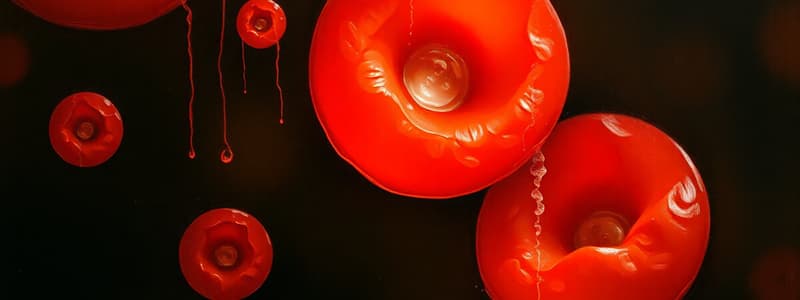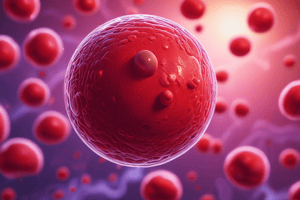Podcast
Questions and Answers
Which characteristic is unique to mature erythrocytes compared to the reticulocyte?
Which characteristic is unique to mature erythrocytes compared to the reticulocyte?
- Size of 7 to 10 μm
- Biconcave disk shape (correct)
- Presence of residual RNA
- Cytoplasm with a bluish tinge
What is the primary composition in the cytoplasm of a reticulocyte?
What is the primary composition in the cytoplasm of a reticulocyte?
- Mainly proteins and lipids
- Predominantly hemoglobin with ribosomes and RNA (correct)
- Transparent with no color
- Salmon pink with central pallor
What are Howell-Jolly bodies?
What are Howell-Jolly bodies?
- Components of mature erythrocytes
- Fragments of extruded nuclei from RBCs (correct)
- Proteins involved in gas exchange
- Immature red blood cells
What is the average life span of a mature erythrocyte?
What is the average life span of a mature erythrocyte?
Which protein in RBC membranes primarily functions as a glucose transporter?
Which protein in RBC membranes primarily functions as a glucose transporter?
What indicates the last stage of hemoglobin synthesis in RBC development?
What indicates the last stage of hemoglobin synthesis in RBC development?
How much of a mature erythrocyte's diameter does the central pallor occupy?
How much of a mature erythrocyte's diameter does the central pallor occupy?
Which statement about reticulocytes is correct regarding their lifespan?
Which statement about reticulocytes is correct regarding their lifespan?
Flashcards
Pyrenocyte
Pyrenocyte
A blood cell with an extruded nucleus engulfed by bone marrow macrophages.
Reticulocyte
Reticulocyte
A young red blood cell containing residual RNA; the last immature erythrocyte stage.
Mature Erythrocyte
Mature Erythrocyte
A mature red blood cell with no nucleus, biconcave disc shape, and a salmon-pink cytoplasm.
Reticulocyte Size
Reticulocyte Size
Signup and view all the flashcards
Mature Erythrocyte Size
Mature Erythrocyte Size
Signup and view all the flashcards
Reticulocyte Cytoplasm
Reticulocyte Cytoplasm
Signup and view all the flashcards
Mature Erythrocyte Cytoplasm
Mature Erythrocyte Cytoplasm
Signup and view all the flashcards
Howell-Jolly Bodies
Howell-Jolly Bodies
Signup and view all the flashcards
Study Notes
Erythrocyte Development
- Pyrenocyte: Enveloped, extruded nucleus engulfed by bone marrow macrophages. Small fragments of the nucleus are left behind, called Howell-Jolly bodies.
- Reticulocyte: 7-10 μm size, no nucleus or nucleolus. Cytoplasm is predominantly hemoglobin, but with a bluish tinge due to residual ribosomes and RNA. Later stages are salmon pink. Last stage of hemoglobin synthesis. Spends 2-3 days in bone marrow and 1 day in peripheral blood before becoming a mature RBC. Irregular shape visible in electron micrographs.
- Mature Erythrocyte: 6-8 μm size, no nucleus, nucleolus, or mitochondria. Salmon pink cytoplasm with a central pallor occupying 1/3 of the cell's diameter. Biconcave disk shape. Average lifespan of 120 days. Normal RBC:WBC ratio is approximately 600:1 and RBC:Platelets ratio is 15:1.
RBC Membrane
- RBC membrane composition: 8% carbohydrates, 40% lipids, 52% proteins (integral and peripheral).
- Transmembrane proteins: Include channel ions, water, and glucose. Provide vertical support connecting the lipid bilayer to the underlying cytoskeleton. Maintain membrane integrity.
- Examples: Aquaporin 1, Band 3, Ca2+-ATPase, Duffy, Glut-1.
- Function:
- Aquaporin 1: Water transporter
- Band 3: Anion transporter, supports ABH antigens
- Ca2+-ATPase: Ca2+ transporter, supports Duffy antigen
- Duffy: Supports Duffy antigen
- Glut-1: Glucose transporter, supports ABH antigens
Studying That Suits You
Use AI to generate personalized quizzes and flashcards to suit your learning preferences.
Description
Test your knowledge on the development stages of erythrocytes, including pyrenocytes, reticulocytes, and mature red blood cells. Understand the structure and composition of the RBC membrane and its components. This quiz will help you grasp the essential biology behind red blood cell formation and function.




